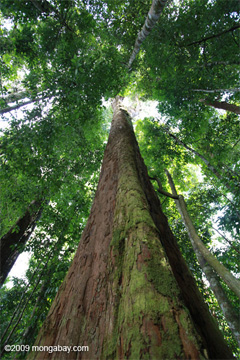|
|
The weak definition of what constitutes forest under the United Nations Framework Convention on Climate Change (UNFCCC) puts the effectiveness of a proposed mechanism for reducing emissions from deforestation and degradation (REDD) at risk, argue researchers writing in the journal Conservation Letters.
Lending academic weight to concerns that environmentalists have long voiced, Nophea Sasaki and Francis E. Putz note that current definitions fail to effectively account for degradation of forests, including industrial logging and conversion of natural forests to some types of plantations. The result: an international climate framework could ignore substantial emissions from forest degradation, a process that reduces forest carbon stock and other ecosystem services, increases the risk of fire, and diminishes biodiversity.
|
|
The UNFCCC defines “forest” as an area of 0.05-1 hectares in size with 10 to 30 percent covered by canopy consisting of trees that reach a height of at least 2-5 meters at maturity. The definition means that an old-growth rainforest can be heavily logged, with substantial amounts of timber (biomass) removed, without recognition of the loss of carbon. Green groups fear that this limitation could allow forestry companies to collect carbon payments while continuing to inflict heavy damage in forest areas.
To illustrate this case, Sasaki and Putz looked at inventory data for forest in central Cambodia. They estimate the forest contains 121.2 metric tons of carbon per hectare, of which 71.4 tons is locked up in trees attractive to loggers. Assuming all these trees were harvested, the area would lose 59 percent of its carbon but still be classified as forest. In the eyes of the UNFCCC, there would be no change in forest cover or carbon storage.
To reduce the impact of such a scenario, Sasaki and Putz recommend new definitions that differentiate natural forest from plantations and set higher thresholds for what counts as forest: a minimum canopy height of 5 meters and 40 percent forest cover. Of course the stricter definition could reduce incentives to conserve habitats with sparse vegetation or a low canopy, like Brazil’s cerrado, a woody grassland that borders the Amazon rainforest, should they not qualify for carbon payments.
Still the authors are hopeful that a better “forest” definition will enable a post-Kyoto climate agreement to account for forest degradation so that it “will help ensure the sustainability of ecosystem services and protect the livelihoods of forest-dependent people while providing a low-cost option for reducing carbon emissions.” New tools — in the sky and on the ground — will also help, improving the reporting and monitoring of forest degradation.
Nophea Sasaki and Francis E. Putz. Critical need for new definitions of “forest” and “forest degradation” in global climate change agreements. Conservation Letters 1755-263X http://dx.doi.org/10.1111/j.1755-263X.2009.00067.x
Related articles
REDD shouldn’t neglect biodiversity say scientists
(07/30/2009) Schemes to mitigate climate change by protecting tropical forests must take into account biodiversity conservation, said two leading scientific organizations at the conclusion of a four day meeting in Marburg, Germany.
Are we on the brink of saving rainforests?

(07/22/2009) Until now saving rainforests seemed like an impossible mission. But the world is now warming to the idea that a proposed solution to help address climate change could offer a new way to unlock the value of forest without cutting it down.Deep in the Brazilian Amazon, members of the Surui tribe are developing a scheme that will reward them for protecting their rainforest home from encroachment by ranchers and illegal loggers. The project, initiated by the Surui themselves, will bring jobs as park guards and deliver health clinics, computers, and schools that will help youths retain traditional knowledge and cultural ties to the forest. Surprisingly, the states of California, Wisconsin and Illinois may finance the endeavor as part of their climate change mitigation programs.

(06/09/2009) A global framework on climate change must immediately halt deforestation and industrial logging of the world’s old-growth forests, while protecting the rights of forest communities and indigenous groups, said a broad coalition of activist groups in a consensus statement issued today at U.N. climate talks in Bonn Germany. The statement said the successor treaty to the Kyoto Protocol should not include mechanisms that allow industrialized countries to “offset” their emissions by purchasing carbon credits from reducing deforestation in developing countries, a position that puts the coalition at odds with larger environmental groups who say a market-based approach with tradable credits is the only way to generate enough money fund forest protection on a global scale.
Forest degradation is huge source of CO2 emissions
(06/05/2009) Selective logging, understory fires, fuelwood harvesting, and other forms of forest degradation are a substantial source of greenhouse has emissions, reports a policy brief issued by The Nature Conservancy (TNC) at U.N. climate talks in Bonn, Germany.
